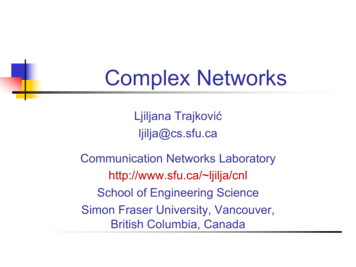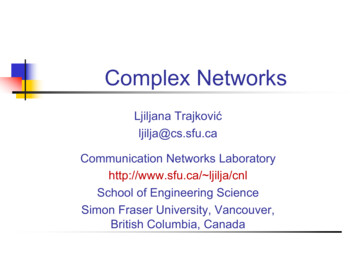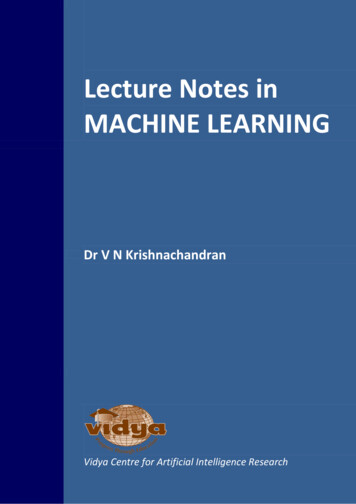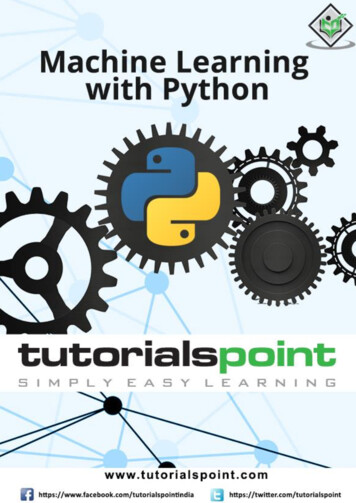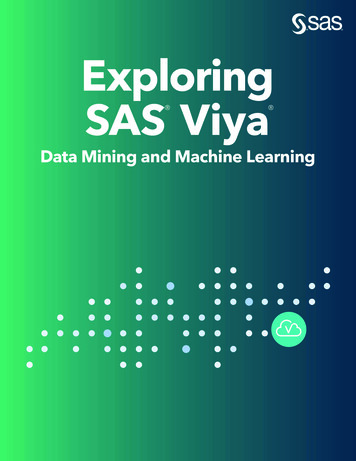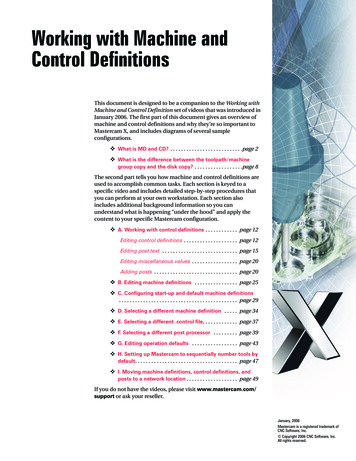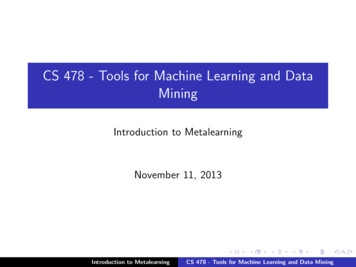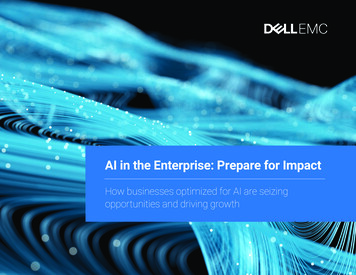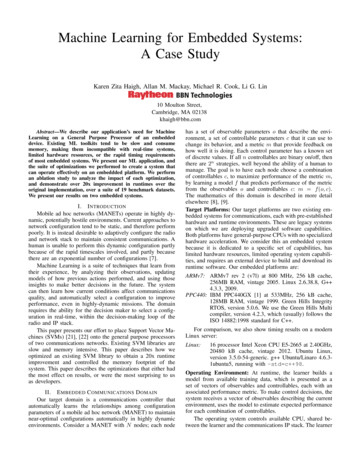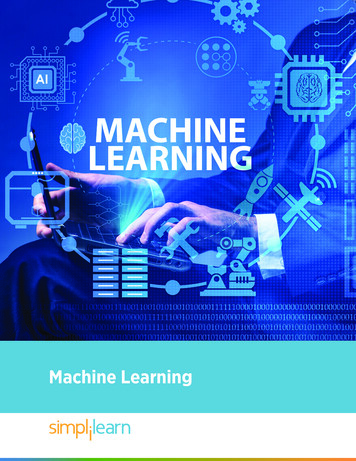
Transcription
Machine Learning
Table of Contents:Program OverviewCertification Details and CriteriaProgram FeaturesCourse CurriculumDelivery ModeCourse end ProjectsPrerequisitesCustomer ReviewsTarget AudienceAbout UsKey Learning OutcomesProgram Overview:This online course offers an in-depth overview of machine learning topics, includingworking with real-time data, developing algorithms using supervised and unsupervisedlearning, regression, classification, and time series modeling. You will also learn how to usePython to draw predictions from data.Program Features:58 hours of blended learning14 hours of Online self-paced learning44 hours of instructor-led trainingFour industry-based course-end projectsInteractive learning with Jupyter notebooks integrated labsDedicated mentoring session from faculty of industry expertsDelivery Mode:Blended - Online self-paced learning and live virtual classroom
Prerequisites:This course requires an understanding of:StatisticsMathematicssPython programmingKnowledge of these fundamental courses:Python for Data ScienceMath RefresherStatistics for Data ScienceTarget Audience:Data analysts looking to upskillData scientists engaged in prediction modelingAny professional with Python knowledge and interest in statistics and mathBusiness intelligence developersKey Learning Outcomes:Master the concepts of supervised and unsupervised learning, recommendation engine, andtime series modelingGain practical mastery over principles, algorithms, and applications of machine learningthrough a hands-on approach that includes working on four major end-to-end projects and25 hands-on exercisesAcquire thorough knowledge of the statistical and heuristic aspects of machine learningImplement models such as support vector machines, kernel SVM, naive Bayes, decision treeclassifier, random forest classifier, logistic regression, K-means clustering and more in PythonValidate machine learning models and decode various accuracy metrics.Improve the final models using another set of optimization algorithms, which include boosting&and bagging techniquesComprehend the theoretical concepts and how they relate to the practical aspects of machinelearning
Certification Details and Criteria:85 percent completion of online self-paced learning or attendance of one live virtual classroomA score of at least 75 percent in the course-end assessmentSuccessful evaluation in at least one projectCourse Curriculum:Lesson 01 - Course IntroductionCourse IntroductionLesson 02 - Introduction to AI and Machine LearningLearning ObjectivesThe emergence of Artificial IntelligenceArtificial Intelligence in PracticeSci-Fi Movies with the concept of AIRecommender SystemsRelationship Between Artificial Intelligence, Machine Learning, and Data Science - Part ARelationship Between Artificial Intelligence, Machine Learning, and Data Science - Part BDefinition and Features of Machine LearningMachine Learning ApproachesMachine Learning TechniquesApplications of Machine Learning - Part AApplications of Machine Learning - Part BKey Takeaways
Lesson 03 - Data PreprocessingLearning ObjectivesData Exploration: Loading FilesDemo: Importing and Storing DataPractice: Automobile Data Exploration IData Exploration Techniques: Part 1Data Exploration Techniques: Part 2SeabornDemo: Correlation AnalysisPractice: Automobile Data Exploration IIData WranglingMissing Values in a DatasetOutlier Values in a DatasetDemo: Outlier and Missing Value TreatmentPractice: Data Exploration IIIData ManipulationFunctionalities of Data Object in Python: Part AFunctionalities of Data Object in Python: Part BDifferent Types of JoinsTypecastingDemo: Labor Hours ComparisonPractice: Data ManipulationKey TakeawaysLesson-end project: Storing Test Results
Lesson 04 - Supervised LearningLearning ObjectivesSupervised LearningSupervised Learning- Real-Life ScenarioUnderstanding the AlgorithmSupervised Learning FlowTypes of Supervised Learning – Part ATypes of Supervised Learning – Part BTypes of Classification AlgorithmsTypes of Regression Algorithms - Part ARegression Use CaseAccuracy MetricsCost FunctionEvaluating CoefficientsDemo: Linear RegressionPractice: Boston Homes IChallenges in PredictionTypes of Regression Algorithms - Part BDemo: BigmartPractice: Boston Homes IILogistic Regression - Part ALogistic Regression - Part BSigmoid ProbabilityAccuracy MatrixDemo: Survival of Titanic PassengersPractice: Iris SpeciesKey TakeawaysLesson-end Project: Health Insurance Cost
Lesson 05 - Feature EngineeringLearning ObjectivesFeature SelectionRegressionFactor AnalysisFactor Analysis ProcessPrincipal Component Analysis (PCA)First Principal ComponentEigenvalues and PCADemo: Feature ReductionPractice: PCA TransformationLinear Discriminant AnalysisMaximum Separable LineFind Maximum Separable LineDemo: Labeled Feature ReductionPractice: LDA TransformationKey TakeawaysLesson-end Project: Simplifying Cancer Treatment
Lesson 06 - Supervised Learning: ClassificationLearning ObjectivesOverview of ClassificationClassification: A Supervised Learning AlgorithmUse CasesClassification AlgorithmsDecision Tree ClassifierDecision Tree: ExamplesDecision Tree FormationChoosing the ClassifierOverfitting of Decision TreesRandom Forest Classifier- Bagging and BootstrappingDecision Tree and Random Forest ClassifierPerformance Measures: Confusion MatrixPerformance Measures: Cost MatrixDemo: Horse SurvivalPractice: Loan Risk AnalysisNaive Bayes ClassifierSteps to Calculate Posterior Probability: Part ASteps to Calculate Posterior Probability: Part BSupport Vector Machines: Linear SeparabilitySupport Vector Machines: Classification MarginLinear SVM: Mathematical RepresentationNon-linear SVMsThe Kernel TrickDemo: Voice ClassificationPractice: College ClassificationKey TakeawaysLesson-end Project: Classify Kinematic DataLesson 07 - Unsupervised LearningLearning ObjectivesOverviewExample and Applications of Unsupervised LearningClusteringHierarchical ClusteringHierarchical Clustering: ExampleDemo: Clustering AnimalsPractice: Customer SegmentationK-means ClusteringOptimal Number of ClustersDemo: Cluster-Based IncentivizationPractice: Image SegmentationKey TakeawaysLesson-end Project: Clustering Image Data
Lesson 08 - Time Series ModelingLearning ObjectivesOverview of Time Series ModelingTime Series Pattern Types Part ATime Series Pattern Types Part BWhite NoiseStationarityRemoval of Non-StationarityDemo: Air Passengers IPractice: Beer Production ITime Series Models Part ATime Series Models Part BTime Series Models Part CSteps in Time Series ForecastingDemo: Air Passengers IIPractice: Beer Production IIKey TakeawaysLesson-end Project: IMF Commodity Price ForecastLesson 09 - Ensemble LearningLearning ObjectivesOverviewEnsemble Learning Methods Part AEnsemble Learning Methods Part BWorking of AdaBoostAdaBoost Algorithm and FlowchartGradient BoostingXGBoostXGBoost Parameters Part AXGBoost Parameters Part BDemo: Pima Indians DiabetesPractice: Linearly Separable SpeciesModel SelectionCommon Splitting StrategiesDemo: Cross-ValidationPractice: Model SelectionKey TakeawaysLesson-end Project: Tuning Classifier Model with XGBoost
Lesson 10 - Recommender SystemsLearning ObjectivesIntroductionPurposes of Recommender SystemsParadigms of Recommender SystemsCollaborative Filtering Part ACollaborative Filtering Part BAssociation Rule MiningAssociation Rule Mining: Market Basket AnalysisAssociation Rule Generation: Apriori AlgorithmApriori Algorithm Example: Part AApriori Algorithm Example: Part BApriori Algorithm: Rule SelectionDemo: User-Movie Recommendation ModelPractice: Movie-Movie recommendationKey TakeawaysLesson-end Project: Book Rental RecommendationLesson 11 - Text MiningLearning ObjectivesOverview of Text MiningSignificance of Text MiningApplications of Text MiningNatural Language Toolkit LibraryText Extraction and Preprocessing: TokenizationText Extraction and Preprocessing: N-gramsText Extraction and Preprocessing: Stop Word RemovalText Extraction and Preprocessing: StemmingText Extraction and Preprocessing: LemmatizationText Extraction and Preprocessing: POS TaggingText Extraction and Preprocessing: Named Entity RecognitionNLP Process WorkflowDemo: Processing Brown CorpusPractice: Wiki CorpusStructuring Sentences: SyntaxRendering Syntax TreesStructuring Sentences: Chunking and Chunk ParsingNP and VP Chunk and ParserStructuring Sentences: ChinkingContext-Free Grammar (CFG)Demo: Twitter SentimentsPractice: Airline SentimentKey TakeawaysLesson-end Project: FIFA World Cup
Projects Covered:Project 1: Uber Fare PredictionDesign an algorithm that will tell the fare to be charged for a passenger.Uber wants to improve the accuracy of its fare prediction model. Help Uber by choosing thebest data and AI technologies for building its next-generation model.Project 2: Mercedes-Benz Greener ManufacturingReduce the time a Mercedes-Benz spends on the test bench.Mercedes-Benz wants to shorten the time models spend on its test-bench, thus moving it to themarketing phase sooner. Build and optimize a machine learning algorithm to solve this problem.Project 3: Amazon.com - Employee AccessDesign an algorithm to accurately predict access privileges for Amazon employees.Use the data of Amazon employees and their access permissions to build a model thatautomatically decides access privileges as employees enter and leave roles within Amazon.Project 4: Income QualificationIdentify the level of income qualification needed for families in Latin America.The Inter-American Development bank wants to qualify people for an aid program. Help the bank tobuild and improve the accuracy of the data set using a random forest classifier.
Customer Reviews:Ashok Kumar KothandapaniSenior Test Manager ar InfosysSimplilearn’s trainers are patient, clearing any confusion and answering all questions without impacting the course timeline. Simplilearn is the most convenient platform for those who want togrow in the fields of Data Analytics and Data Science.Asmita WankhadeStudent at NITThe course content is excellent. You can learn and understand,even if you are only a beginner. I am delighted to have joined andsuccessfully finished the 'Certified Machine Learning’ course. Allthanks to Simplilearn.Mahesh GaonkarSenior Analyst Programmer at EmiratesSimplilearn is a great start for the beginner as well for the experiencedperson who wants to get into a data science job. Trainers are wellexperienced and we get more detailed ideas on the concepts andexercises. I could finish my Machine Learning advance course veryeasily with good project exercise.Sharanya NairBusiness Analyst at GenpactI had completed Tableau, R, and Python training courses fromSimplilearn. These courses helped a lot in moving ahead in mycareer path. Now, I am pursuing an MS in Data Science. Thank you,Simplilearn!
About Us:Simplilearn is a leader in digital skills training, focused on the emerging technologies thatare transforming our world. Our blended learning approach drives learner engagementand is backed by the industry’s highest completion rates. Partnering with professionals andcompanies, we identify their unique needs and provide outcome-centric solutions to helpthem achieve their professional goals.For more information, please visit our ursesimplilearn.comFounded in 2009, Simplilearn is one of the world’s leading providers of online training for Digital Marketing,Cloud Computing, Project Management, Data Science, IT Service Management, Software Development andmany other emerging technologies. Based in Bangalore, India, San Francisco, California, and Raleigh, NorthCarolina, Simplilearn partners with companies and individuals to address their unique needs, providingtraining and coaching to help working professionals meet their career goals. Simplilearn has enabled over 1million professionals and companies across 150 countries train, certify and upskill their employees.Simplilearn’s 400 training courses are designed and updated by world-class industry experts. Theirblended learning approach combines e-learning classes, instructor-led live virtual classrooms, appliedlearning projects, and 24/7 teaching assistance. More than 40 global training organizations have recognizedSimplilearn as an official provider of certification training. The company has been named the 8th mostinfluential education brand in the world by LinkedIn.India – United States – Singapore 2009-2019 - Simplilearn Solutions. All Rights Reserved.The certification names are the trademarks of their respective owners.
Acquire thorough knowledge of the statistical and heuristic aspects of machine learning Implement models such as support vector machines, kernel SVM, naive Bayes, decision tree classifier, random forest classifier, logistic regression, K-means clustering and more in Python Validate machine lear

